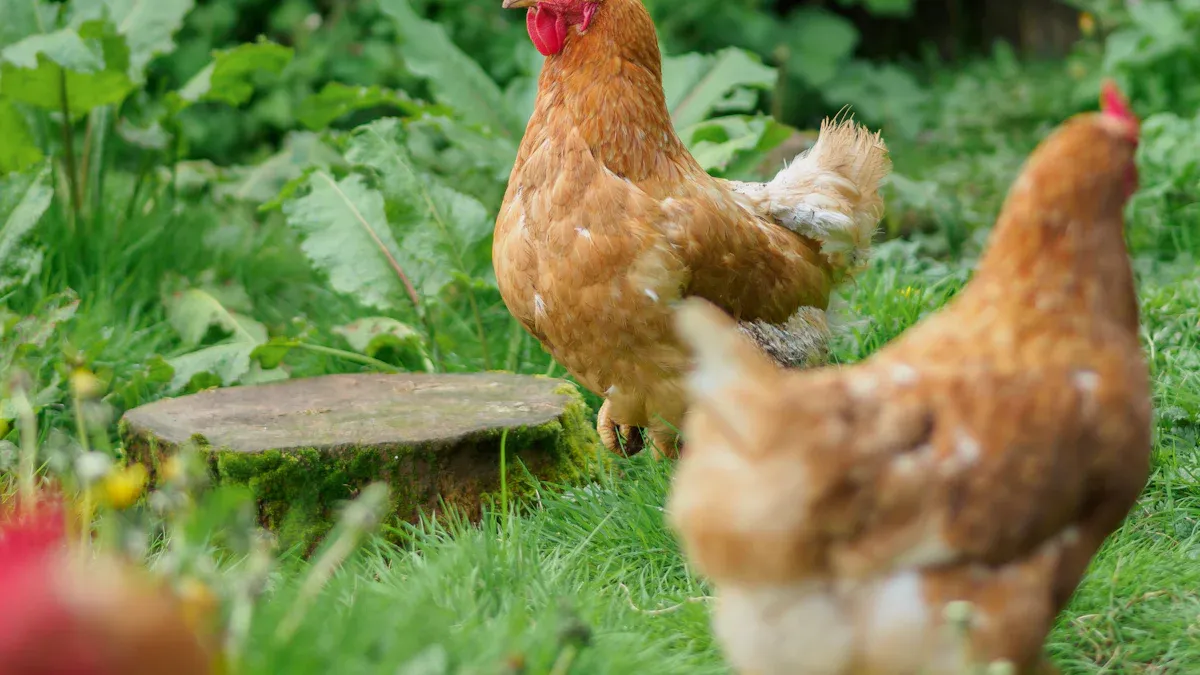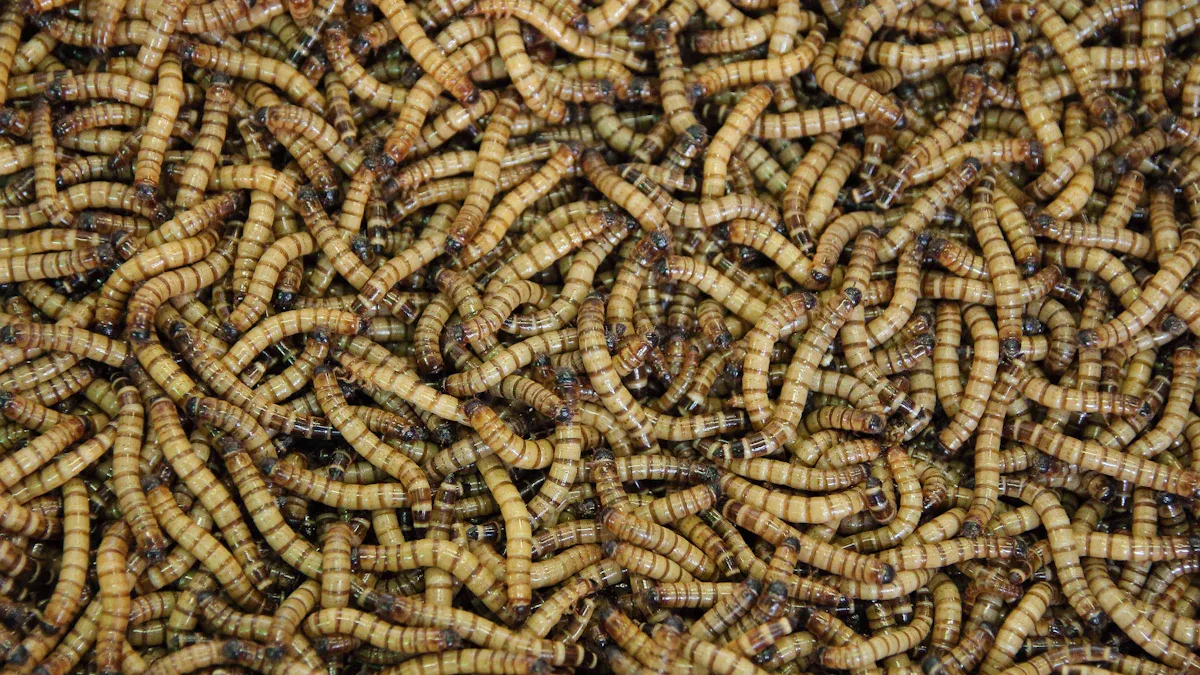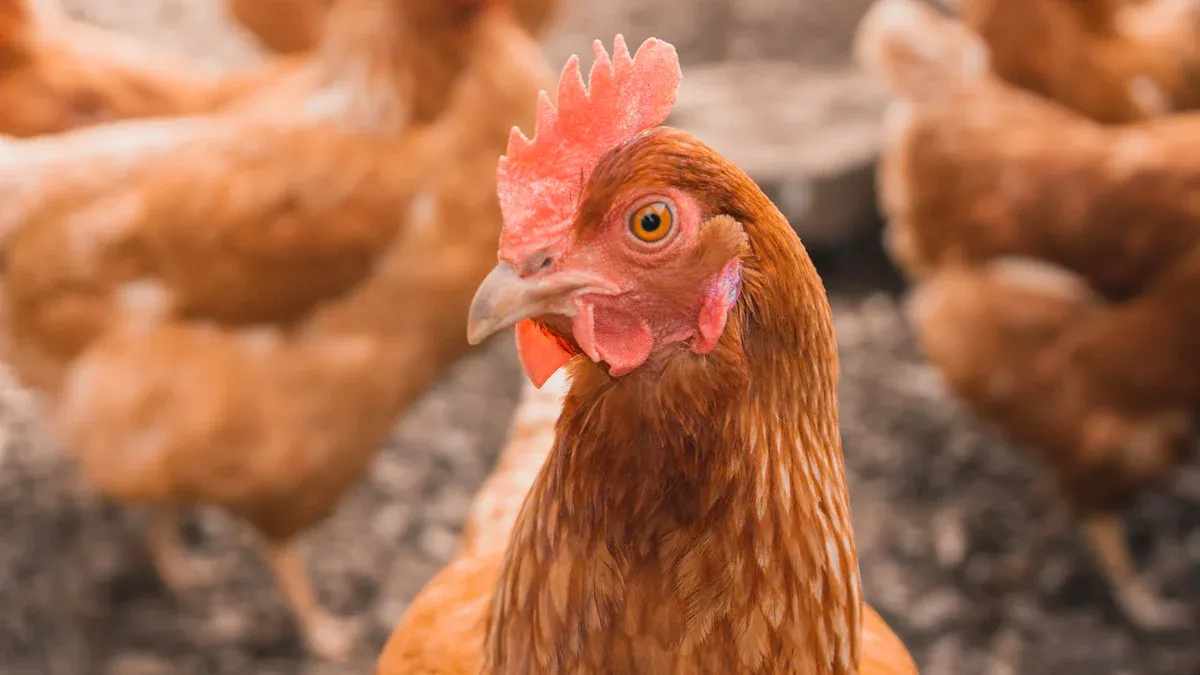
Middle East poultry farms are turning to mealworms protein as a game-changer. This innovative feed option offers high nutritional value while using fewer resources, making it ideal for sustainable farming. With significantly lower greenhouse gas emissions than traditional livestock feed, mealworms are paving the way for eco-friendly poultry practices. By 2025, they’ll play a vital role in meeting the rising demand for protein without straining the planet.
Key Takeaways
- Mealworms protein is a healthy food that helps chickens grow well. It improves their weight and keeps them strong.
- Feeding chickens mealworms uses fewer resources and lowers pollution. This makes it a green choice for farming.
- Adding mealworms to chicken diets improves eggs and increases production. This meets customer needs and helps farmers earn more money.
Nutritional Benefits of Mealworms Protein

High Protein Content for Poultry Growth
Mealworms protein is packed with nutrients that poultry need to thrive. Its high protein content makes it an excellent choice for supporting the growth and development of chickens. Protein is essential for building muscle and maintaining healthy feathers, and mealworms deliver this in abundance. Unlike traditional feed options, mealworms protein provides a concentrated source of nutrition, helping poultry grow faster and healthier.
Farmers in the Middle East are already noticing the difference. Chickens fed with mealworms protein show improved weight gain and overall vitality. This makes it a practical and efficient solution for farms aiming to boost productivity without compromising quality.
Essential Amino Acids for Poultry Health
Mealworms protein doesn’t just stop at being rich in protein; it’s also loaded with essential amino acids. These amino acids are the building blocks of life, playing a crucial role in poultry health. They support everything from tissue repair to enzyme production, ensuring chickens stay strong and active.
Research on yellow mealworms (Tenebrio molitor) highlights their impressive nutritional profile. They contain all the essential amino acids poultry need, making them a complete protein source. This is particularly important for farmers looking to optimise their feed for better results. With mealworms protein, chickens get the nutrients they need to thrive, reducing the risk of deficiencies and improving overall health.
Boosting Immune System and Vitality
A strong immune system is vital for poultry, especially in large-scale farming operations. Mealworms protein contributes to this by providing key nutrients that enhance immunity. Chickens fed with mealworms protein are better equipped to fight off diseases, reducing the need for medical interventions.
The high fat content in mealworms also plays a role in boosting energy levels. This helps chickens stay active and maintain their vitality, which is crucial for egg production and overall farm efficiency. Farmers who incorporate mealworms protein into their feed notice healthier flocks and improved performance, making it a win-win solution for sustainable farming.
Environmental and Economic Advantages
Sustainability and Reduced Resource Use
Mealworms protein offers a sustainable alternative to traditional livestock feed. Its production requires fewer resources, making it an eco-friendly choice for poultry farming. Unlike conventional protein sources, mealworms need less land, water, and energy to produce the same amount of protein. This efficiency helps reduce the strain on natural resources, which is especially important in regions like the Middle East, where water scarcity and arid land are significant challenges.
To illustrate the environmental benefits, consider the following data:
| Impact Category | Mealworms (per kg) | Comparison to Organic Broiler |
|---|---|---|
| CO2-eq (kg) | 20.4 | 18-72% lower impacts |
| Energy Use (MJ-eq) | 213.66 | 18-72% lower impacts |
| Land Use (m²) | 22.38 | 18-72% lower impacts |
This table highlights how mealworms protein significantly reduces carbon emissions, energy consumption, and land use compared to organic broiler production. By adopting mealworms protein, poultry farmers can contribute to a more sustainable agricultural system while meeting the growing demand for high-quality poultry products.
Lower Carbon Footprint of Mealworms Protein
Mealworms protein stands out for its remarkably low carbon footprint. Its production generates greenhouse gas emissions that are 10–100 times lower than beef production. Unlike traditional livestock, mealworms produce negligible amounts of methane, a potent greenhouse gas. This makes them a climate-friendly option for poultry feed.
Additionally, mealworms have an impressive feed conversion efficiency. They require only 1.7 kg of feed to produce 1 kg of protein, compared to 8 kg for beef. This efficiency not only reduces resource use but also minimises the environmental impact of feed production. By switching to mealworms protein, poultry farmers can play a vital role in combating climate change while maintaining high productivity.
Cost Savings for Middle East Poultry Farmers
Economic benefits are another compelling reason for Middle East poultry farmers to embrace mealworms protein. Traditional protein sources like fishmeal and soybean meal contribute significantly to feed costs, often accounting for 60% to 70% of total expenses. In contrast, insect-based protein, including mealworms, offers a more cost-effective alternative.
| Protein Source | Cost Contribution (%) |
|---|---|
| Fishmeal and Soybean Meal | 60% – 70% |
| Insect-based Protein | Lower than conventional sources |
Insect farming reduces feed costs by replacing expensive conventional protein sources. As prices for traditional feed ingredients continue to rise, mealworms protein provides a stable and affordable option. Farmers who adopt this innovative feed can lower their operational costs while maintaining or even improving the quality of their poultry products.
Moreover, mealworms farming aligns well with local conditions in the Middle East. It requires minimal water and space, making it a practical solution for regions with limited agricultural resources. By integrating mealworms protein into their operations, farmers can achieve both economic and environmental sustainability.
Practical Applications in Poultry Farming

Promoting Natural Foraging Behaviour
Mealworms protein encourages chickens to engage in their natural foraging instincts. Chickens love to scratch and peck, and mealworms provide the perfect incentive for this behaviour. Scattering mealworms around the coop or yard mimics their natural environment, keeping them active and entertained. This not only improves their physical health but also reduces stress levels, leading to happier and healthier flocks.
Farmers have found that incorporating mealworms into feeding routines helps reduce aggressive behaviours among chickens. When chickens are busy foraging, they are less likely to engage in harmful pecking or fighting. This simple addition to their diet creates a more harmonious environment, benefiting both the birds and the farmers.
Enhancing Egg Quality and Production
Adding mealworms protein to poultry diets has a noticeable impact on egg quality and production. Chickens fed with mealworms lay eggs with darker, more vibrant yolks. This is due to the rich nutritional content of mealworms, particularly their fatty acids. These nutrients also contribute to better feather development and overall body repair.
- Mealworms are a protein-rich snack that supports growth and recovery.
- Chickens fed mealworms produce eggs with improved yolk colour and nutritional value.
- Farmers report increased egg production when mealworms are part of the diet.
This improvement in egg quality not only satisfies consumer demand but also boosts the market value of the eggs. For farmers, it’s a win-win situation.
Supporting Antibiotic-Free Farming Practices
Mealworms protein plays a key role in supporting antibiotic-free farming. Its high nutritional value strengthens the immune system of chickens, making them less prone to diseases. Healthier chickens mean fewer medical interventions, which aligns with the growing demand for antibiotic-free poultry products.
By reducing the reliance on antibiotics, farmers can meet consumer expectations while maintaining ethical farming practices. Mealworms protein offers a natural way to enhance poultry health, ensuring sustainable and responsible farming for the future.
Mealworms protein offers a triple advantage: better nutrition, eco-friendly farming, and practical applications. It’s a smart choice for Middle East poultry farmers aiming for sustainability. By adopting this innovative feed, they can reduce costs, improve poultry health, and protect the planet. 🌍
The future of poultry farming starts with mealworms protein.
Article author: Felix
FAQ
What makes mealworms protein a sustainable choice for poultry farming?
Mealworms require minimal land, water, and energy to produce. Their low carbon footprint makes them an eco-friendly alternative to traditional feed sources. 🌱
Can mealworms protein replace traditional poultry feed entirely?
Yes, mealworms can replace traditional feed. However, many farmers prefer combining them with other feed to create a balanced and cost-effective diet.
Are mealworms safe for poultry to consume?
Absolutely! Mealworms are natural, nutrient-rich, and safe for poultry. They support growth, health, and vitality without any harmful additives.
Tip: Gradually introduce mealworms into poultry diets to ensure a smooth transition and optimal results.


